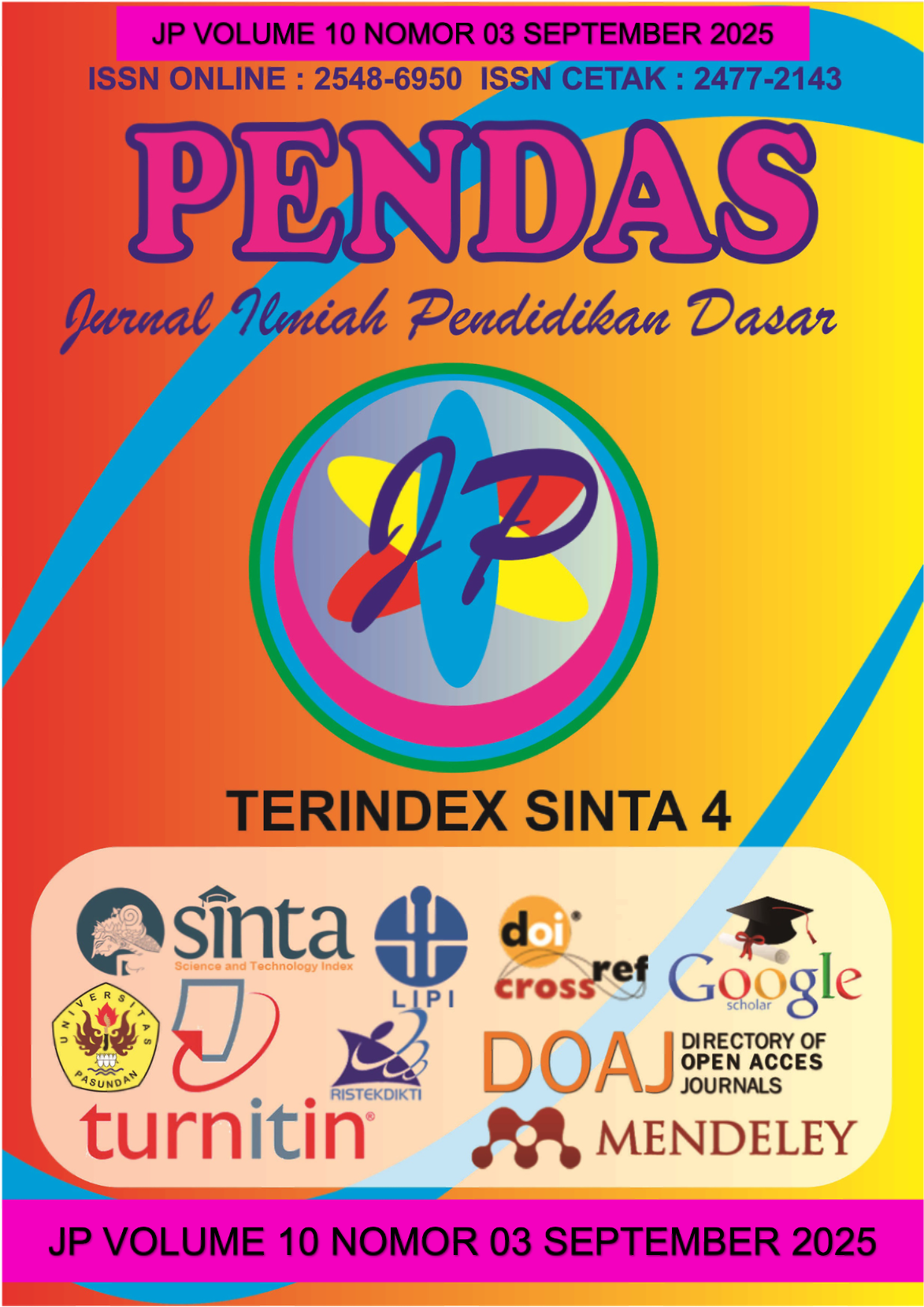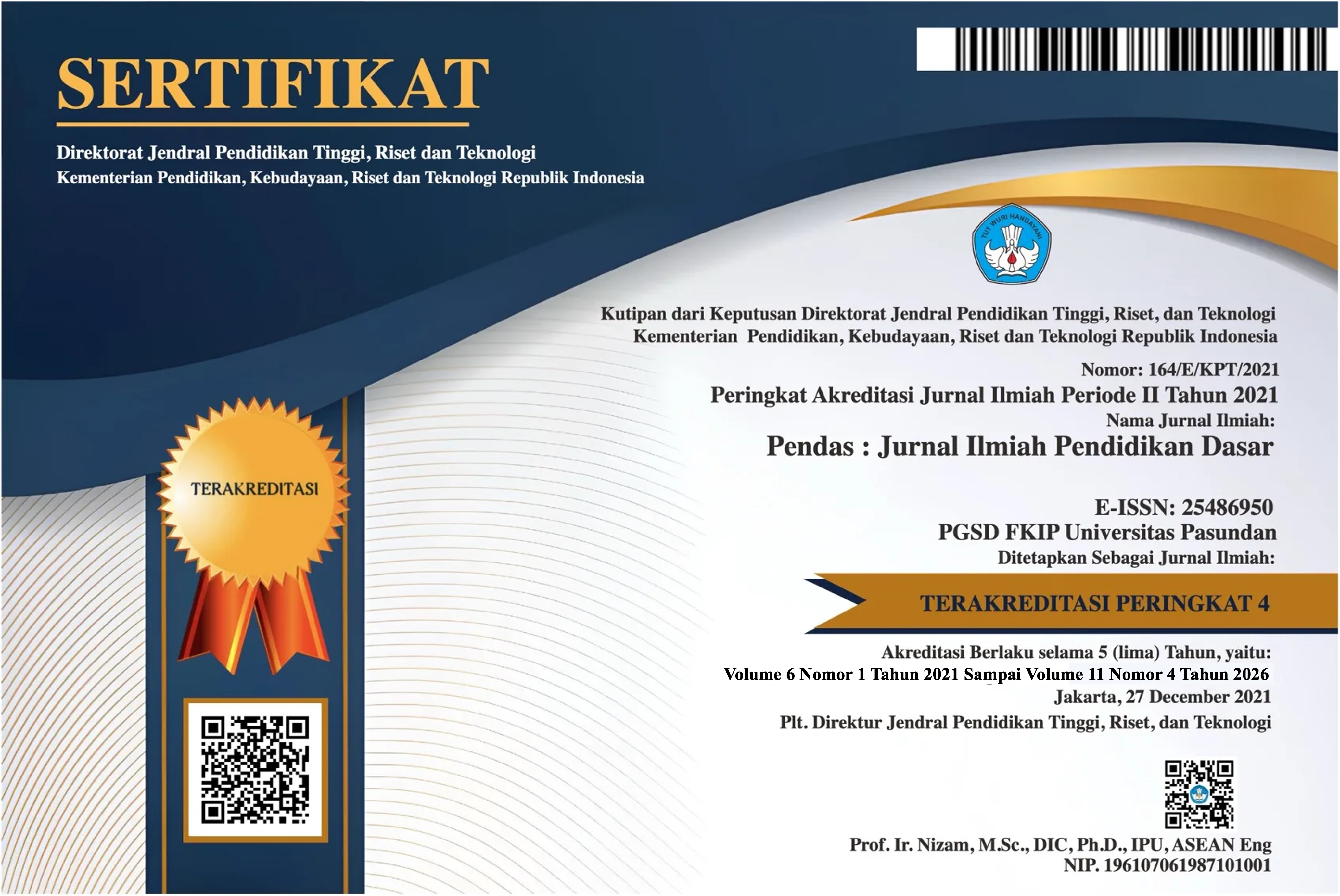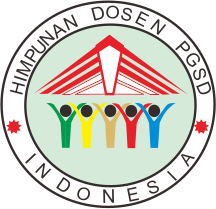IMPLEMENTASI MODEL PEMBELAJARAN HAND ON ACTIVITY TERHADAP SISWA KELAS IV SEKOLAH DASAR
DOI:
https://doi.org/10.23969/jp.v10i03.29038Keywords:
Hand on Activity, Learning Model, Elementary School, Student Motivation, Active LearningAbstract
This research was motivated by the low learning motivation and high absenteeism among fourth-grade students at SDN Rawabuaya 03 Pagi. Preliminary observations revealed that the lack of student engagement was caused by monotonous, teacher-centered learning methods that failed to stimulate students’ curiosity and participation. This study aims to describe the implementation of the Hand on Activity learning model and analyze its impact on students' motivation and learning outcomes. This research employed a qualitative descriptive approach, with data collected through observation, interviews, and documentation. The research subjects consisted of the principal, classroom teacher, and fourth-grade students.. The results of the study indicate that the Hand on Activity learning model significantly increases student participation, motivation, and understanding. Students are more enthusiastic about participating in learning when directly involved in practical activities rather than passive listening. Teachers utilize learning tools such as group discussions, experiments, and real-life simulations to create a more interactive and enjoyable learning environment. Additionally, involving parents through communication before the learning process helps students prepare better for classroom activities. Despite some challenges, such as limited learning media and facilities, the application of the Hand on Activity model proves effective in enhancing cognitive, psychomotor, and social skills. This research concludes that the Hand on Activity model is highly effective for primary education as it fosters active learning, improves student attendance, and enhances learning outcomes. Therefore, this model is recommended for wider implementation in elementary schools to create a more engaging and meaningful learning process
Downloads
References
Budi, C. (2018). Buku Manajemen Pembelajaran. UNNES PRESS. https://lib.unnes.ac.id/47913/1/Buku%20Manajemen%20Pembelajaran.pdf
Djumingin, S. (2017). PENILAIAN PEMBELAJARAN BAHASA DAN SASTRA INDONESIA Teori dan Penerapannya. Badan Penerbit Universitas Negeri Makassar. https://eprints.unm.ac.id/8412/2/BUKU%20PENILAIAN%20UTUH.pdf
Fory. (2016). STRATEGI PENGELOLAAN PEMBELAJARAN. https://repository.ung.ac.id/get/kms/10726/strategi-pengelolaan-pembelajaran.pdf
Mubarok, I., Nana, N., & Sulistyaningsih, D. (2020). ANALISIS PENERAPAN MODEL PEMBELAJARAN POE2WE BERBASIS HANDS ON ACTIVITY TERHADAP KEMAMPUAN BERPIKIR KRITIS SISWA. EduFisika, 5(02), 104–111. https://doi.org/10.22437/edufisika.v5i02.10804
Pinasthika, R. P., & Kaltsum, H. U. (2022). Analisis Penggunaan Metode Eksperimen pada Pembelajaran IPA di Sekolah Dasar. Jurnal Basicedu, 6(4), 6558–6566. https://doi.org/10.31004/basicedu.v6i4.3304
Putri, Y. I., & Ulya, V. F. (2023). PENERAPAN MODEL PEMBELAJARAN HANDS ON ACTIVITY DENGAN MEDIA HANDMADE UNTUK MENINGKATKAN MOTIVASI BELAJAR MATEMATIKA. 04. https://doi.org/10.37850/ibtida’.
Sakmal, J., Nur Fajriah, T., & Dallion, E. (2024). PENERAPAN MODEL PEMBELAJARAN KOOPERATIF TIPE STAD DALAM MENINGKATKAN HASIL BELAJAR IPA SISWA SEKOLAH DASAR. Jurnal IKA PGSD (Ikatan Alumni PGSD) UNARS, 15(1), 1. https://doi.org/10.36841/pgsdunars.v15i1.4544
Sani, M. (2016). KEGIATAN MENUTUP PELAJARAN. Journal of Accounting and Business Education, 1(3). https://doi.org/10.26675/jabe.v1i3.6031
Tadhkiroh, T., Akbar, B., & Hartini, T. I. (2023). Pengembangan Instrumen Penilaian Kinerja pada Muatan IPA Kurikulum 2013 Tingkat Sekolah Dasar. Jurnal Basicedu, 7(1), 631–644. https://doi.org/10.31004/basicedu.v7i1.4720
Waluny, A., Nazihah, A. F., Nirwana, A., & Wulandari, S. (2024). PERAN GURU KELAS DALAM MENANGANI SISWA BERKEBUTUHAN KHUSUS SLOW LEARNER DI SEKOLAH DASAR. 09.
Yuliana, I., & Supriati, N. (2022). MENGHADIRKAN PEMAHAMAN MATEMATIKA DENGAN METODE HANDS OF ACTIVITY. COLLASE (Creative of Learning Students Elementary Education), 5(3), 617–623. https://doi.org/10.22460/collase.v5i3.5597
Zahara, L. (2018). Penerapan Model Hands On Activity Untuk Meningkatkan Hasil Belajar Mahasiswa. Kappa Journal, 2(2), 28. https://doi.org/10.29408/kpj.v2i2.1212
Zakiah, L. (2017). HUBUNGAN KEAKTIFAN DALAM KEGIATAN PRAMUKA DAN MOTIVASI BELAJAR PENDIDIKAN KEWARGANEGARAAN PADASISWAKELAS IV SEKOLAH DASAR. JURNAL PENDIDIKAN DASAR, 8. https://doi.org/10.21009/JPD
Zakiah, L., Handayani, P. T., Pasha, N. M., Zahra, A. S., & Jaya, I. (2024). PENTINGNYA PENDIDIKAN MULTIKULTURAL DAN PENDIDIKAN INKLUSI DI SEKOLAH DASAR DALAM MENGHARGAI KEBERAGAMAN : STUDI LITERATUR. Pendas : Jurnal Ilmiah Pendidikan Dasar, 09.
Zakiah, L., Harianto, R. P., & Sumantr, M. S. (2024). TINGKAT KEDISIPLINAN BELAJAR TERHADAP PRESTASI BELAJAR SISWA. Volume 09 Nomor 02. https://doi.org/10.23969/jp.v9i2.13197
Zakiah, L., Lalita, A. C., Haikal, D. R., & Aswati, D. (2024). The Effect of Multicultural Education on the Tolerant Attitudes of Elementary School Students: A Literature Study. PENDIDIKAN MULTIKULTURAL, Universitas Islam Malang, 8. https://riset.unisma.ac.id/index.php/MULTI/article/view/21579/16223
Zakiah, L., & Marini, A. (2023). Teachers’ strategies in teaching social tolerance to elementary school students in Jakarta, Indonesia. Issues in Educational Research, 33(2), 839–855.
Zakiah, L., Sarkadi, Marini, A., Komarudin, Casmana, A. R., & Kusmawati, A. P. (2023). Implementation of Teaching Multicultural Values Through Civic Education for Elementary School Students. Journal of Social Studies Education Research, 14 (1), 110–142.
Downloads
Published
Issue
Section
License
Copyright (c) 2025 Pendas : Jurnal Ilmiah Pendidikan Dasar

This work is licensed under a Creative Commons Attribution 4.0 International License.



















